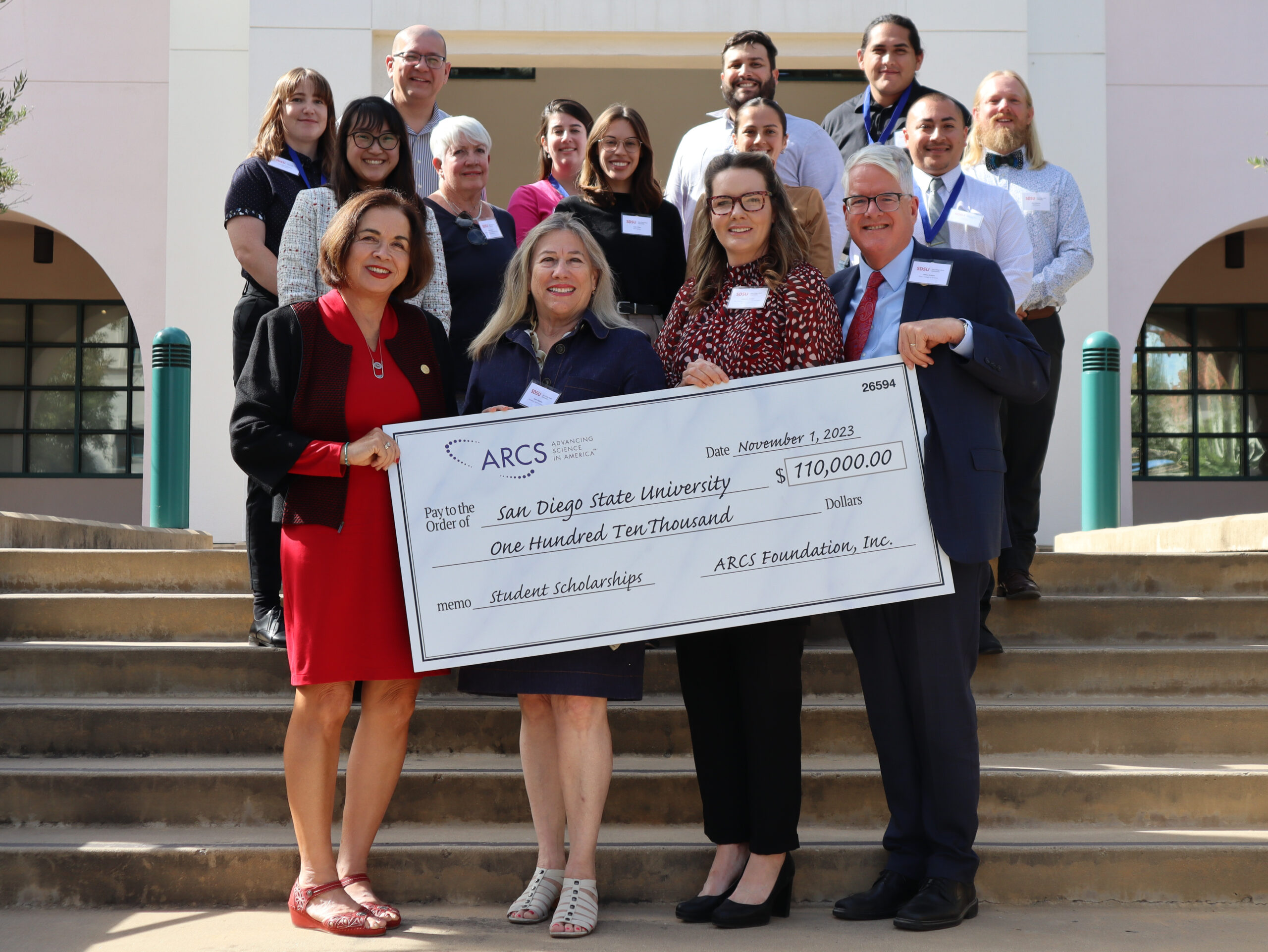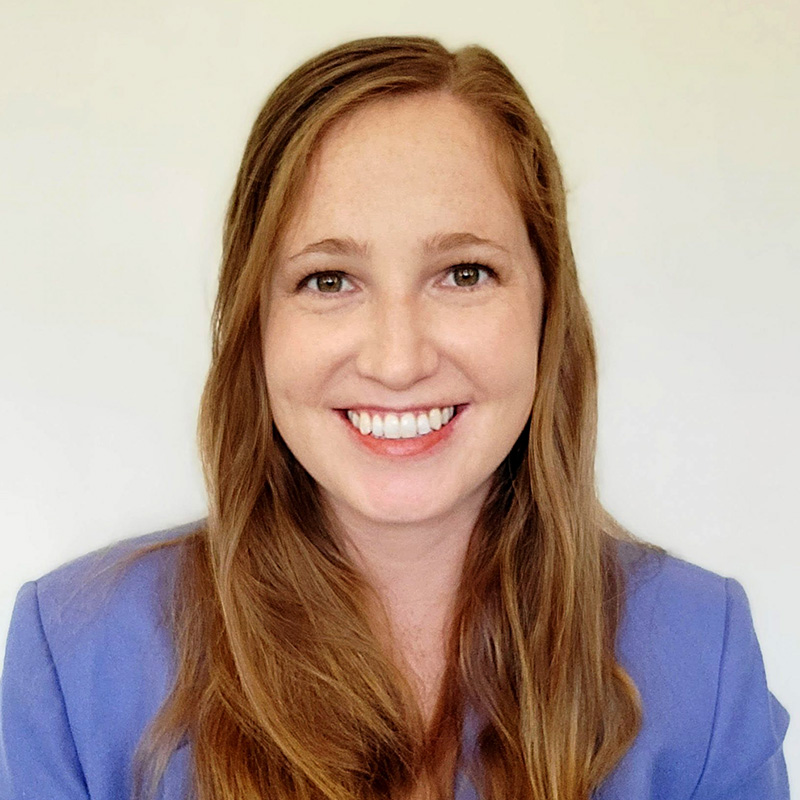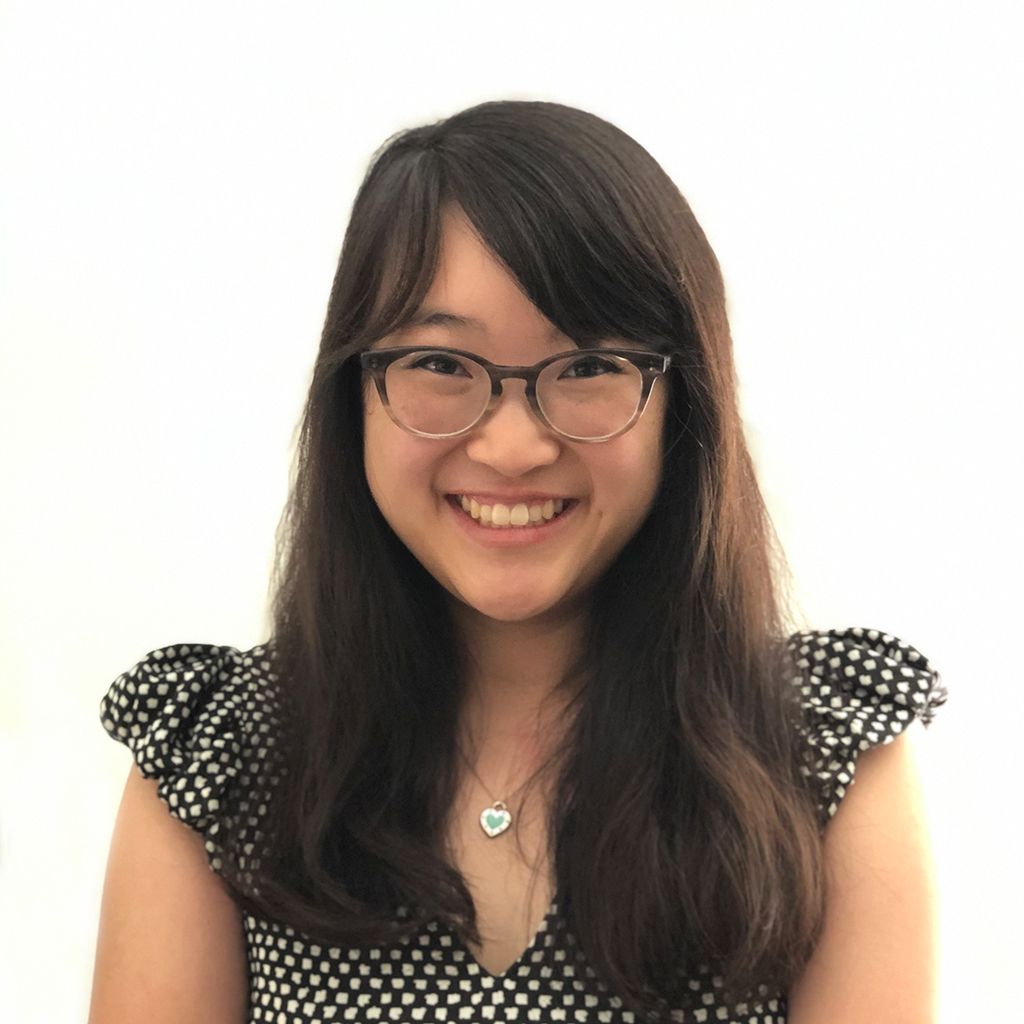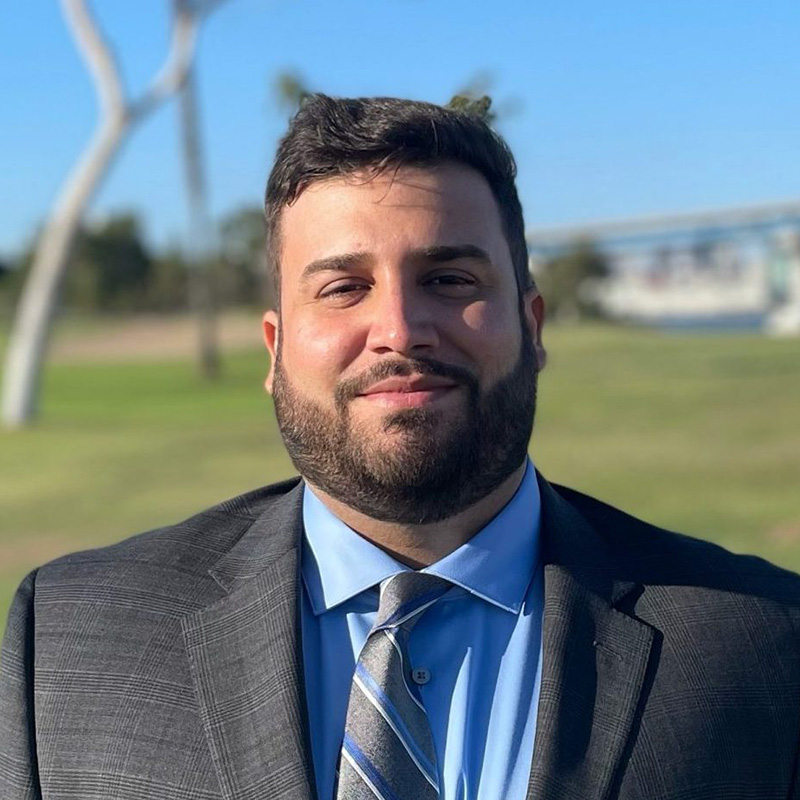
San Diego ARCS Chapter presenting a check to President Adela de la Torre.
ARCS® Foundation is a nationally recognized organization run entirely by women philanthropists. Their mission is to boost American leadership and advancement in science and technology by providing funding to help the country’s most brilliant students create knowledge and innovative technologies.
The San Diego Chapter of ARCS began in 1985 and has grown from the original four founders to more than 100 members today. Over 460 San Diego State University scholars have been awarded upwards of $3.3 million in scholarships over the past 32 years.
Achievement Rewards for College Scientists 2023–2024:
- Jason Baer
- Luis Cruz
- Jessica Griffin
- Ryan Hanscom
- Tiffany Luong
- Adrian Rivera
- Jovan San Martin
- Ashley Schwartz
- Laura Sisk-Hackworth
- Lilith Vasquez
- Isabel White
Current Scholars
Jessica Eileen Griffin
Ph.D. Ecology (candidate)
Community ecology of eelgrass beds in a changing ocean
Joint SDSU & UC Davis
B.S. in Ecology and Evolutionary Biology, Environmental Sciences
University of Connecticut
About Jessica
Jessica is a marine ecologist born and raised in southeastern Connecticut. After graduating from the University of Connecticut with her bachelor’s degree and working at the University of Vermont as a research technician, she came to SDSU to earn a PhD in marine community ecology with Dr. Kevin Hovel. Her research interests are rooted in a commitment to conservation of marine ecosystems, which she pursues through her studies on interactions between eelgrass and bivalves in California bays and estuaries. She plans to pursue a career where she can use her graduate training to inform conservation of coastal habitats such as seagrass beds, mangroves, and salt marshes, all of which provide vital habitat to marine organisms and important services to people.
Personal Interests
I enjoy hiking, exploring new places, and reading both memoirs and historical fiction.
My ARCS Award
I am grateful to receive recognition and support through this award. It is particularly meaningful to me that the ARCS Foundation is a women-run organization, and I hope to pass on their support by mentoring women in my field as my career advances. I am honored to become a part of the ARCS community, and appreciate that this award will allow me to focus on my research without undue financial stress.
Award Donor
The Heller Foundation of San Diego
Current Research
I study interactions between bivalves and eelgrass in California bays and estuaries, and how these interactions are affected by anthropogenic change, such as climate change and invasive species. In particular, I study how invasive Asian mussels affect native fauna in eelgrass beds, and I study how light and temperature mediate interactions between clams and eelgrass. Bivalves filter particles out of the water, providing more light for eelgrass photosynthesis and growth; however, in some cases bivalves excrete toxic chemicals that may harm eelgrass. I ask whether environmental conditions may hold the key to why interactions vary under different circumstances. These questions are becoming increasingly important as climate change and eutrophication affect temperature and water clarity in eelgrass beds.
Publications & Posters
Griffin, J.E., B.P. O’Malley, and J.D. Stockwell. 2020. The freshwater mysid Mysis diluviana (Audzijonyte & Väinölä, 2005) (Mysida: Mysidae) consumes detritus in the presence of Daphnia (Cladocera: Daphniidae). Journal of Crustacean Biology 40(5): 520 – 525.
Griffin, J.E., G. Park, and H.G. Dam. 2019. Relative importance of nitrogen sources, algal alarm cues and grazer exposure on toxin production of the marine dinoflagellate Alexandrium catenella. Harmful Algae 84: 181 – 187.
Becker, D.M., J.E. Griffin, and C. Miller. Identifying factors that contribute to positive and negative student experiences at field-based institutions (in) Women of the Wild: Challenging gender disparities at field stations and marine laboratories. Lexington Books, Washington, D.C. in press.
Awards & Honors
Dr. Susan Lynn Williams Memorial Graduate Award; COAST Graduate Student Research Award; Mesa Foundation Innovation Grant
Benefits to Science and Society
My research focuses on understanding threats to California eelgrass beds, such as climate change, invasive species and eutrophication. Eelgrass beds provide vital ecosystem services, such as wave attenuation, reduction of sediment erosion, and creation of habitat for economically important animals, such as Dungeness crabs. My research will contribute to conservation of these important habitats and the services they provide to society.
Laura Sisk-Hackworth
Ph.D. Cell and Molecular Biology (student)
Host-Microbe Interactions
Joint SDSU & UC San Diego
B.S. Biological Sciences
California Polytechnic State University
About Laura
Personal Interests
In my free time, I enjoy reading, gardening and hiking.
My ARCS Award
I am so grateful to the support from the ARCS foundation. I greatly appreciate the networking opportunities that being an ARCS scholar presents and the validation that comes from recognition by such a wonderful organization! Support from the ARCS foundation also greatly reduces financial stress, so that I can focus more on the research and mentoring that I love.
Award Donor
Ellen Browning Scripps Foundation
Current Research
You probably remember puberty as a time of immense and confusing changes, but you might not know that the microbes in your gut were changing with you! My research focuses on how the physiological changes that we experience during puberty, like soaring hormone levels and metabolic shifts, affect which microbes live in our gut and what they do there! Knowing how puberty shapes the gut microbiome will help us better understand microbiome-related diseases that emerge during puberty, like polycystic ovary syndrome and type I diabetes.
Awards & Honors
2020-2021 CMB Joint Doctoral Program Outstanding Research Achievement Travel Award, 2020-2021; Rees-Stealy Research Foundation Fellowship, 2021; Finalist, Student Research Competition, SCASM Virtual Student/Educator Meeting, 2021; National Institutes of Health F31 Fellowship (Perfect Score), 2021-2024
Benefits to Science and Society
Puberty is a critical period in human development with lasting impacts on health. Some diseases that emerge during puberty, such as polycystic ovary syndrome, endometriosis, type I diabetes, and irritable bowel disease, are strongly linked to the gut microbiome in sex-specific ways. Likewise, many sex-specific physiologies that emerge during puberty, such as immune function and cognition, associate with gut microbiome composition. Therefore, knowing how puberty shapes the gut microbiome will increase understanding of how these diseases and key aspects of physiology develop. This will open the door for more microbiome-based therapies and prevention strategy. To date, no studies have investigated a causal role of puberty in the sex-specific differentiation of the gut microbiome. My research will fill this gap by revealing how puberty causes the sex-specific maturation of the gut microbiome.
Tiffany Luong
Ph.D. Cell and Molecular Biology (candidate)
Phage Biology
Joint SDSU & UC San Diego
B.S. Molecular, Cell, and Developmental Biology
University of California Los Angeles
About Tiffany
Bacteriophage (viruses that can selectively infect and kill bacteria) treatment currently lacks approval in the United States, but can be deployed as an emergency treatment when antibiotics can no longer treat life-threatening bacterial infections. During Tiffany’s PhD research, she developed a phage production and purification methods to produce high-quality, clinically safe phage preparations for personalized patient treatment. Importantly, this method addresses the current bottleneck hampering access to rapid phage therapy and aims to standardize the purification of phage particles for research and clinical applications to ensure patient safety. Her ongoing research will address the tripartite interaction between phages, bacteria, and mammalian cells to better optimize and ensure the safety of phage therapy.
Personal Interests
My interests include the traditional Chinese game mahjong, food and travel, video games, building model kits, and science fiction and fantasy literature.
My ARCS Award
ARCS has had a profound impact on my development as a scientist and a scientific communicator in the last year. ARCS has connected me with Dr. Steffanie Strathdee, an inspirational female scientist in the phage community, and allowed me to not only share my research with her, but to receive her support and mentorship. Recognition as an ARCS scholar has allowed me to share my research with my peers as well as other amazing women who support the ARCS community.
My current research project has allowed me to perform state-of-the-art experiments that generate large genomic data sets, rich with clues as to how phages and mammalian cells interact (RNA-seq) as well as how bacteria mutate in response to phage treatment (DNA sequencing). Support from ARCS has made it possible for me to obtain equipment (laptop, computational resources) for my training as a bioinformatician. This has been critical to my productivity as a scientist and for the next stages of my project. Ongoing support from ARCS will enable me to attend not only bioinformatics workshops and training, but also to attend international conferences next year.
Award Donor
Hervey Family Fund
Current Research
Bacteriophages, phages for short, are viruses that specifically infect bacteria and are currently under investigation for their ability to treat drug-resistant bacteria infections. In the last few decades, phages have been used in clinical studies worldwide to treat a variety of life-threatening drug-resistant bacterial infections. Several clinical studies conducted in the United States and Europe have supported the safety of phage use, though not necessarily its efficacy.
I reviewed recent clinical phage studies to decipher the nuances of phage treatment and its outcomes. Of the 59 clinical trials and single patient studies conducted between 2005-2020, 50 case studies reported successful resolution of bacterial infections or improvement of chronic infections during treatment using phages and antibiotics (Luong et al. 2020, Clinical Therapeutics).
However, the production, administration, and treatment of phages remains non-standard, making it difficult to precisely identify how phages should be formulated for widespread use. As with antibiotics, bacteria can mutate to become phage-resistant. As part of my PhD research, I have begun a project deciphering how to select phage that minimize bacterial resistance during phage therapy, how to dose for single or dual-phage treatments, and how to best minimize undesirable bacterial mutations that result from phage treatment.
Finally, my ongoing thesis work continues to study the interactions between phages and the innate immune system. In the last year I have exposed phages to lung epithelial (surface) cells and immune cells such as macrophages (first responders to pathogens in the body). By collecting genetic material from the cells at different time points, I am studying what types of signals are released by the cells in response to phages. I am currently analyzing these data sets to decipher whether phages elicit specific pro-inflammatory responses or anti-inflammatory responses, and what cellular pathways are affected by these signals.
Ultimately, I plan on using these results to study how phage therapy can be conducted as safely as possible in the future.
Publications & Posters
Luong T, Schumann A, Conrad D, Roach D: Draft genome sequence of the multidrug-resistant strain Pseudomonas aeruginosa PA291, isolated from cystic fibrosis sputum. Microbiology Resource Announcements 2021, 10(36):e0057221.
Luong, T.; Salabarria, A.-C.; Roach, D.R. Phage therapy in the resistance era: Where do we stand and where are we going? Clinical Therapeutics 2020, 42, 1659-1680
Luong, T.; Salabarria, A.; Edwards, R.A.; Roach, D.R. Standardized bacteriophage purification for personalized phage therapy. Nature Protocols 2020, 15 (9), 2867-2890
Mizuno, C.M.; Luong, T.; Cederstrom, R; Krupovic, M.; Debarbieux, L.; Roach, D.R. Isolation and characterization of bacteriophages that infect citrobacter rodentium, a model pathogen for intestinal diseases. Viruses 2020, 12, 737
Flyak, A.I.; Ruiz, S.; Colbert, M.D.; Luong, T.; Crowe, J.E.; Bailey, J.R.; Bjorkman, P.J. HCV broadly neutralizing antibodies use CDRH3 disulfide motif to recognize an E2 glycoprotein site that can be targeted for vaccine design. Cell Host & Microbe 2018, 24, 703–716
Awards & Honors
ARCS Award 2020-2021; San Diego State University Graduate Fellowship 2021; Rees-Stealy Research foundation Fellowship 2021; 3rd Place, 3 Minute Thesis Competition, SDSU
Benefits to Science and Society
Phage therapy is a treatment currently under investigation for its ability to treat both acute and chronic drug-resistant bacterial infections. I am currently investigating the efficacy and safety of this therapy. However, phages require bacterial hosts to replicate, making purification of phages incredibly important to prevent bacterial residues from harming patients. During my PhD, I developed a method to highly purify phage formulations for use in clinical treatments. To date, we identified and purified phages for emergency clinical use against a variety of bacterial infections including bacteremia (bacteria in the blood), osteomyelitis (bone infection) and even chronic infections in patients with cystic fibrosis (genetic lung disease).
In addition to my ongoing research projects, I have also worked with non-profit organizations to publish trilingual (English/Spanish/Bulgarian), K-12 accessible phage research in the Science Journal for Kids and Teens as well as to provide training and phage resources to scientists at COANIQUEM, an NGO that helps children with burn wounds.
Adrian Rivera
Ph.D. Structural Engineering (student)
Joint SDSU & UC San Diego
B.S. in Aerospace Engineering
San Diego State University
About Adrian
Adrian Rivera is currently a 4th year doctoral student in the SDSU/UCSD Joint Doctoral Program in the Structural Engineering Department. His research is focused on analyzing manufacturing imperfections in aluminum honeycomb sandwich composites. The impact of this research will increase the understanding of how imperfections affect the material performance of aluminum honeycomb cores, allowing engineers to better identify potential failure of future aerospace structural designs.
As a doctoral student, Adrian has interned at NASA Glenn Research Center as well as NASA Langley Research Center. Adrian was born in San Diego, California and his family originated in Puerto Rico where he was drawn to aerospace from his visits to the Arecibo Observatory. In 2018, Adrian Rivera was awarded the NASA Fellowship Activity which has funded his research that has led to 2 conference publications. Recently, Adrian has been awarded the ARCS scholarship for the 2021-2022 cohort which will allow him to continue his work until his expected graduation of June 2023. After the completion of the doctorate, he plans to continue his work as a Pathways position at NASA Glenn Research Center and being part of the foundation of the Artemis Generation to get us back on the moon and beyond. As an undergraduate at SDSU, Adrian was a IMSD scholar and has been involved in local outreach throughout San Diego County providing science day seminars and STEM activities at public libraries.
Personal Interests
My personal interests include tennis and cooking. As a former barista I also have a passion for coffee.
My ARCS Award
The ARCS award will help me continue to focus on my current research as well as continue outreach with mentoring of undergraduate and transfer students. For me the award allows young scholars to continue pushing the boundaries of science and promote inclusion and community among SDSU graduate students. This is increasingly more important with the new normal that is living in a pandemic.
Award Donor
ARCS Foundation – San Diego Chapter
Current Research
My current research is focused on analyzing manufacturing imperfections in aluminum honeycomb sandwich composites. Aluminum honeycomb core is a common structural component that has been used in a range of industries from automotive to aerospace. The manufacturing of these aluminum honeycomb cores introduces a variety of imperfection sources that can change the expected performance of the initial design.
To better understand the effect of imperfections on performance, a detailed model was constructed using X-ray computed tomography. CT scans are routinely used to create 3D images of human body parts. In a similar fashion, a much stronger CT scan was used to capture the resultant honeycomb structure after the manufacture of a panel with the same specifications as one used on a space launch system.
The X-ray images were converted into finite element models which simulated load conditions for compression and pure shear in order to understand the effects that imperfections have on the compression strength and transverse shear respectively. It was found that imperfections through the thickness of the aluminum honeycomb, such as waviness, introduced during the curing process of the composite panels, significantly reduced the compression performance of the aluminum honeycomb core.
Publications & Posters
(2021) Characterization and Modeling of Cell Wall Imperfections in Aluminum Honeycomb Cores using X-ray CT Imaging. AIAA Scitech 2021 Forum.
(2019) Investigation of crushed response of aluminum honeycomb sandwich composites and sensitivity to manufacturing imperfections. NASA Glenn Research Symposium 2019.
(2018) Characterization of Low-velocity Impact Damage in Sandwich Composite Panels. San Diego State Research Symposium. San Diego, United States.
(2017) A numerical study to investigate the effects of impact damage in buckling-critical honeycomb sandwich structures. NASA Langley Research Center Structural Branch Meeting. Hampton, VA.
(2017) A numerical study to investigate the effects of impact damage in buckling-critical honeycomb sandwich structures. ABRCMS Conference. Phoenix, AZ.
Benefits to Science and Society
The impact of this research will increase the understanding of how imperfections affect the material performance of aluminum honeycomb cores, allowing engineers to better identify potential failure of future aerospace structural designs. Furthermore, the tools used to construct finite element models of honeycomb core materials can be used for design optimization, improving the reliability and performance of fracture critical structures. The broad impact of this research can be seen in safety equipment as well as a non-destructive evaluation method for airplane wing parts that use aluminum honeycomb core materials. Being able to predict performance of parts with manufacturing imperfections will help in gauging correctly the life span of critical components, potentially saving lives during commercial airline travel as well as manned space missions.




